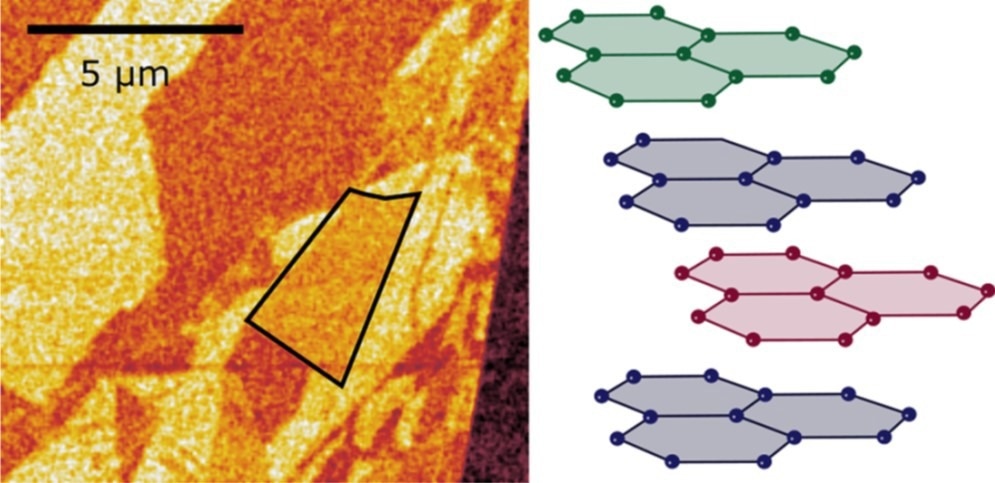Tetralayer graphene comprises three inequivalent stacking layers, of which two have been determined thus far, namely, rhombohedral (ABCA) and Bernal (ABAB) stacking.

Study: Experimental Observation of ABCB Stacked Tetralayer Graphene. Image Credit: RWTH Aachen University
The third elusive stacking, ABCB, contains a unique electronic structure with an intrinsic bandgap and locally flat bands around K points. A recent study published in ACS Nano identified and characterized domains of ABCB stacked tetralayer graphene using confocal Raman microscopy and scattering-type scanning near-field optical microscopy(s-SNOM).
Stackings of Graphene Layers
Typically, the optical and electronic properties are greatly influenced by the stacking order of few-layer graphene (FLG). Several interesting phenomena have been reported in naturally occurring crystallographic graphene; for example, single and bilayer graphene exhibited quantum Hall states. Additionally, when Bernal stacked bilayer graphene is exposed to a magnetic field, superconductivity is demonstrated.
Artificially stacked graphene layers with twisted angles revealed flat bands and unconventional superconductivity. Furthermore, twisted bilayer graphene exhibited ferromagnetic insulating states. In contrast to rhombohedral stacking, Bernal stacking is commonly found, which possesses energetically favorable configuration in FLG stacking.
Trilayer graphene has been receiving significant attention due to its stacking structure, which influences optoelectric and magnetoelectric properties. Compared to monolayer and bilayer graphene structures, trilayer structures exhibit greater ferromagnetism. Rhombohedral four-layer (ABCA) graphene possesses a ferrimagnetic insulating state.
In addition to rhombohedral and Bernal (ABAB) stackings, tetralayer graphene also contains a mixed stacking, which is metastable. The mixed stacking is known as ABCB, which is composed of equivalent stackings of ABCB and ABAC. Tetralayer graphene with ABCB stacking demonstrated a unique electronic band structure.
ABCB is considered the thinnest graphene-based intrinsic band insulator, with a band gap of 8.8 meV. Its electronic structure is not related to Bernal or rhombohedral stacked graphene. However, the low energy spectrum of ABCB containing a locally flat band interconnected with a massive Dirac cone is responsible for its robust van Hove singularities at the band edges.
The stacking orders were determined using Confocal Raman spectroscopy in FLG. Even though advanced spectroscopy methods, such as magneto-Raman spectroscopy, can be used to characterize the stacking order of graphene, this method is sensitive to electronic structures at the Fermi edge. Additionally, common far-field spectroscopy methods cannot determine small domains that are mainly present on unknown crystallographic stackings.
Experimental Evidence for ABCB Stacked Tetralayer Graphene
Different analytical tools were used to characterize the varied graphene stacking orders. Spectral absorption of FLG was measured in the infrared range between 0.2 and 0.9 eV, which provided a characteristic peak around the interband transitions. This peak was linked to the electronic structure of tetralayer graphene. Hence, this peak could be used to differentiate between ABCA and ABAB stacked tetralayer graphene.
When the photon energies are more than 0.2 eV, s-SNOM can be used to determine the stacking-specific optical properties of FLG. This process can also be used to acquire scattering amplitude and phase values. IR nanospectroscopy was applied to analyze bilayer graphene that was subjected to conductivity resonances at 0.39 eV.
Here, third-order phase signals and optical amplitude were obtained using s-SNOM. Two segments of tetralayer graphene were separated by a small stripe of trilayer graphene. Importantly, tetralayer graphene was mostly homogeneous except for two diagonal folds.
sSNOM demonstrated that varied near-field responses originated from different optical conductivities across tetralayer graphene structures. Since conductivities have been linked to electronic structure, the unique near-field responses were associated with three crystallographic stackings, i.e., ABAB, ABCA, and ABCB.
Interestingly, confocal Raman spectroscopic analysis of the FLG exhibited G, M, and 2D peaks. Raman spectra of the G and 2D peaks of the three-stacking order of tetralayer graphene were studied. Compared to ABAB, Raman spectra analysis revealed a shift in the G peak position of ABCA stacking.
For ABCB domains, slightly higher energy was observed in the G peak compared to the other two stackings. The full width at half-maximum (fwhm) line width of the G peak was the largest in ABAB domains and smallest in ABCA domains. The 2D and M peaks that emerged from two-phonon processes were extremely sensitive to the electronic structure. Hence, both peaks revealed unique line shapes for three stacking orders. The Raman spectral analysis of tetralayer graphene confirmed the findings of s-SNOM.
To analyze optical conductivity, sequential nanospectroscopy was conducted between 0.28 and 0.56 eV, along with theoretical modeling. It was observed that the above-mentioned IR region could be used to differentiate the three stacking orders. Fourier transform infrared microspectroscopy (FTIR) also provided distinct IR spectral reflectance for three tetralayer graphene stackings.
Based on experimental results, ABCB domains were confirmed to be metastable at room temperature. This finding is also in line with theoretical predictions, where the energy barriers between ABAB and ABCB have been estimated to be lower than ABCA and ABCB.
The current study revealed that near-field spectroscopy could be used as a semi-quantitative tool to identify ABCB domains in tetralayer graphene flakes, which would positively help in future research.
Reference
Wirth, G. K. et al. (2022) Experimental Observation of ABCB Stacked Tetralayer Graphene. ACS Nano. https://doi.org/10.1021/acsnano.2c06053
Disclaimer: The views expressed here are those of the author expressed in their private capacity and do not necessarily represent the views of AZoM.com Limited T/A AZoNetwork the owner and operator of this website. This disclaimer forms part of the Terms and conditions of use of this website.